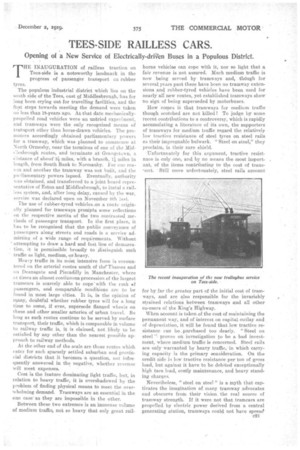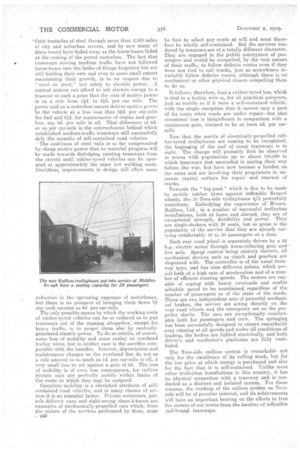TEES-SIDE RAILLESS CARS.
Page 9

Page 10

If you've noticed an error in this article please click here to report it so we can fix it.
Opening of a New Service of Electrically-driren Buses in a Populous District.
THE INAUGURATION of railless traction on Tees-aide is a noteworthy landmark in the progress of passenger transport on rubber :tyres.
The populous industrial district which lies on the south side of the Tees, east of Middlesbrough, 'has for long been crying out for travelling facilities, and the first steps towards meeting the demand were taken no less than 18-years ago. At that date mechanicallypropelled road vehicles were an untried experiment, and tramways were the only recognized means of transport other than horse-drawn vehicles. The promoters accordingly obtained parliamentary powers for a tramway, which was planned to commence at North Ormesby, near the terminus of one of the Mid(:lesbrough routes, and terminate at Grangetown, a (';istance of .about' 3i miles, with a branch, 11 miles in length, from South Bank to Normanby. For one reaSon and another the tramway was not built, and the parliamentary powers lapsed. Eventually, authority was obtained, and transferred to a joint board representative of Eston and Middlesbrough, to instal a railless system, and, after long delay, caused by the war, service was declared open on November 8th last.
The use of rubber-tyred vehieles.on a route originally planned for tramways prompts some reflections on the respective merits of the two contrasted methods of passenger transport. In the first, place, it has to be recognized that the public conveyance of passengers along streets and roads is a service admitting of a wide range of requirements. Without ' attempting to draw a hard and fast line of demarca.
• tion, it is permissible broadly to aistinguish such ' traffic as light, medium, or heavy.
Heavy traffic in its mast intensive form is encountered on the arterial routes south Of the-Thaanes and on Deansgate and Piccadilly in Manchester, where at times an almost continuous procession of the largest tramcars is scarcely able to cope' with the rush af passengers, and Comparable conditions are to be found in most large ,cities. It is, in the opinion of many, doubtful whether rubber tyres will for a long time to come, if ever, supersede flanged wheels on these and other smaller arteries of urban travel. 1So long as such routes continue to be served by surface transport, their traffic, which is comparable in volume to railway traffic is, it is claimed, not likely to be • satisfied by any other than the nearest possible approach to railway methods.
At the other end of the scale are those routes which cater for such sparsely settled suburban and provincial diAricts that it becomes R. question, not. infrequently answered in the negative, whether revenue will meet expenses.
Cost is the feature dominating light traffic, but, in relation to heavy traffic, it is overshadowed by the problem of finding physical means to meet the overwhelming demand. Tramways are an essential in the one case as they are impossible in the other.
Between these two extremes is an immense volume of medium traffic', not so heavy that only great rail borne vehicles can cope with it, nor so light that a fair revenue is not assured. Much medium traffic is now being served by tramways and, thdugh for several years past there have been no tramway extensions and rubber-tyred vehicles have been used for nearly all" new routes, yet established tramways show nQ sign of being superseded by motorbuses.
How comes it that tramways for medium traffic though scotehed are not killed? To judge by some recent contributions to a controversy, which is rapidly accumulating a literature of its own, the supporters of tramways for medium, traffic regard the relatively low tractive resistance of steel tyres on steel rails as their impregnable bulwark. "Steel on steel," they proclaim, is their sure shield.
'Unfortunately for this argument, tractive resistance is only one, and by no means the most important, of the items contributing tothe ooat of trans • )ort. • Still more unfortunately, steel rails account for by far the greater part of the initial cost of tramways, and are also responsible for the invariably strained relations between tramways and all other co-users of the King's Highway.
When account is taken of the cost of maintaining the permanent way, and of interest on capital outlay and. of depreciation, it will be found that low tractive resistanee can be .purchased too dearly. "Steel on steel ", proves on investigation to be a bad investment, where medium traffic) is concerned. Steel rails are only warranted by heavy traffic, in which carrying capacity is the primary consideration. On the credit side i low tractive resistance per ton of gross load, but against it have to be debited exceptionally high tare load, costly maintenance, and heavy standing charges.
Nevertheless, "steel on steel" is a myth that captivates the imagination of many tramway advocates and obscures from their vision the real source of tramway strength. If it were not that tramcars are propelled by electric power derived from a central generating station, tramways could not have spread • their tentacles, of steel through more than 2,500 miles (IF. city and suburban streets, and by now many of them would have faded away as the horse-buses faded at the-coming of the petrolmotorbus. The fact that • tramways serving mediuni traffic have not followed horse-buses into the limbo of things forgotten but are still holding their own and even to some small extent maintaining their growth, is in no respect due to " steel on steel," hut solely to electric power. A central station can afford tc; sell electric energy to a tramcar at such a price that the cost of Motive power is as a rule from lid. to 20. per car mile. The power unit on a motorbus cannot deliver motive power 1..o the vehicle at a less 'cost than 5id. per car-mile for fuel and 2.1d. for maintenance of engine and gearbox, say 8d. per mile in all. That difference of 6d. or so per car-mile is the entrenchment behind which established medium-traffic tramways still successfully defy the assaults of self-contained road vehicles.
The costliness of steel rails is so far compensated by cheap motive power that no material progress will be made towards dislodging existing tramways from the streets until rubber-tyred vehicles can be operated at appsoximately the same low werking costs. Doubtless, improvements in design will effect some reduction in the operating expenses of motorbuses, but there is no prospect of bringing them down by any such amount as 6d. per car-mile.
The only possible means by which the working costs of rubber-tyred vehicle.s can be so reduced as to put tramways out of the running altogether, except for heavy traffic, is to propel them also by centrallygenerated electric power To do so entails, of course, some loss of mobility and some outlay on overhead trolley wires, but in neither case is the sacrifice comparable-with the benefits. Interest, depreciation and maintenanoe charges on the overhead line do not as a rule amount to so much as id. per car-mile in all, a very small loss to set against a gain of 6d. The-loss of mobility is of even less consequence, for railless electric cars are perfectly mobile within limits of the route to which they may be assigned.
Complete mobility is a cherished attribute of selfcontained road vehicles, and in Many classes of ser-. viee it is an essential factor. Private motorcars, parcels delivery vans and sight-seeing chars4-bancs are examples of mechanically-propelled cars which, from the nature of the services performed by them, must be free to select any route at will and must therefore be wholly self-contained. But the services rendered by tramcars are of a totally different eharacter. They are engaged in the public conveyance of passengers and would be compelled, by the very nature of their traffic, to follow definite routes even if they were not tied to rail tracks, just as motorbuses invariably follow definite routes, although there is no mechanical or other physical reason compelling them to do so.
It follows, therefore, that a rubber-tyred bus, whieh is tied to a trolley wire is, for all practical purposes, just as mobile as if it were a self-contained vehicle, with the single exception that it eannot vary a part of its route when roads are under repair—but that occasional loss is insignificant in comparison with a continuous gain, claimed to be at least 5d. per carmile.
Now that the merits of electrically-propelled rubber-tyred trolleybuses are coming to be recognized, the beginning of the end of many tramways is in sight. The change will probably first be observed in towns with populations up to about 100,000 in which tramways just succeeded in paying their way before the war, but have now become a. burden on the rates and are involving their proprietors in immense capital outlays for repair and renewal of tracks.
' Towards the " big-push " which is due to be made by _mobile rubber tyres against inflexible flanged wheels, the 10 Tees-side trolleybuses 'ill powerfully contribute. Embodying the experience of Messrs. 'tailless, Ltd., in a number of successful trolleybus installations, both at home and abroad, they are of exceptional strength, durability and power. They are single-deckers with 28 seats, but so great is the popularity of the service that they are already carrying comfortably 40 to 50 passengers at a time.
Each rear road wheel is separately driven by a 23 h.p. electric motor through worm-reducing gear and live axle. Speed control being entirely electric, all . mechanical devices such as clutch and gearbox are • dispensed with. The controller is of the usnal tramway type, and has nine -different points, which permit both of a high rate of acceleration and of a number of efficient running speeds. The motors are capable of coping with heavy overloads and enable schedule speed to be maintained regardless of the number of passengers or of the state of the roads. There are two independent sets of powerful mechanical brakes, the service set acting directly on the rear road wheels and the emergency set on the propeller shafts. The cars are exceptionally comfortable both or passengers and crew. Tho springing hos been 5uccessfully designed to ensure remarkably easy running at all speeds and under all conditions of loading, the bodies are lighted electrically, and both driver's and conductor's platforms are fully vestibuled.
The Tees-side Tailless system is remarkable not only for the excellence of its rolling stock, but for the low price at which energy is purchased and also for the fact that it is self-contained. Unlike most other trolleybus installations in this country, it has no physical connection with a tramway and is eonducted as a distinct and isolated system. For these reasons, the working of the railless system on Teesside will be of peculiar interest, and its achievements will have an important bearing on the efforts to free the streets of our towns from the incubus of inflexible rail-bourn:1 traraways.


























